实验一
1、实验任务一
源代码:

// 现代C++标准库、算法库体验 // 本例用到以下内容: // 1. 字符串string, 动态数组容器类vector、迭代器 // 2. 算法库:反转元素次序、旋转元素 // 3. 函数模板、const引用作为形参 #include <iostream> #include <string> #include <vector> #include <algorithm> // 模板函数声明 template<typename T> void output(const T &c); void test1(); void test2(); void test3(); int main() { std::cout << "测试1: \n"; test1(); std::cout << "\n测试2: \n"; test2(); std::cout << "\n测试3: \n"; test3(); } // 输出容器对象c中的元素 template <typename T> void output(const T &c) { for(auto &i : c) std::cout << i << ' '; std::cout << '\n'; } // 测试1:组合使用算法库、迭代器、string反转字符串 void test1() { using namespace std; string s0{"0123456789"}; cout << "s0 = " << s0 << endl; string s1(s0); // 反转s1自身 reverse(s1.begin(), s1.end()); cout << "s1 = " << s1 << endl; string s2(s0.size(), ' '); // 将s0反转后结果拷贝到s2, s0自身不变 reverse_copy(s0.begin(), s0.end(), s2.begin()); cout << "s2 = " << s2 << endl; } // 测试2:组合使用算法库、迭代器、vector反转动态数组对象vector内数据 void test2() { using namespace std; vector<int> v0{2, 0, 4, 9}; cout << "v0: "; output(v0); vector<int> v1{v0}; reverse(v1.begin(), v1.end()); cout << "v1: "; output(v1); vector<int> v2{v0}; reverse_copy(v0.begin(), v0.end(), v2.begin()); cout << "v2: "; output(v2); } // 测试3:组合使用算法库、迭代器、vector实现元素旋转移位 void test3() { using namespace std; vector<int> v0{0, 1, 2, 3, 4, 5, 6, 7, 8, 9}; cout << "v0: "; output(v0); vector<int> v1{v0}; // 将[v1.begin(), v1.end())区间内元素循环左移1位 rotate(v1.begin(), v1.begin()+1, v1.end()); cout << "v1: "; output(v1); vector<int> v2{v0}; // 将[v1.begin(), v1.end())区间内元素循环左移2位 rotate(v2.begin(), v2.begin()+2, v2.end()); cout << "v2: "; output(v2); vector<int> v3{v0}; // 将[v1.begin(), v1.end())区间内元素循环右移1位 rotate(v3.begin(), v3.end()-1, v3.end()); cout << "v3: "; output(v3); vector<int> v4{v0}; // 将[v1.begin(), v1.end())区间内元素循环右移2位 rotate(v4.begin(), v4.end()-2, v4.end()); cout << "v4: "; output(v4); }
运行结果图:
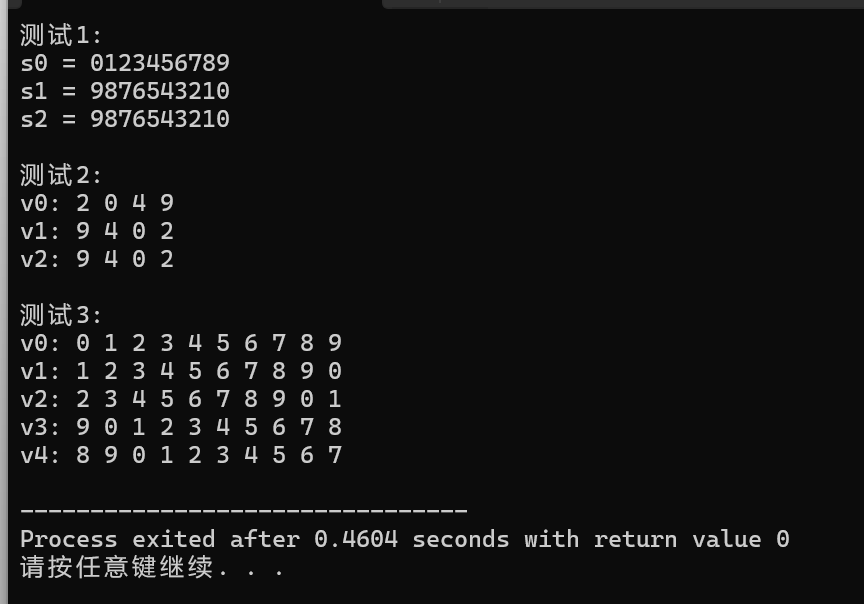
观察与思考:
问题一:reverse 和 reverse_copy 有什么区别?
reverse直接对变量本身进行反转,reverse将变量反转后的结果复制到新的变量中,变量本身不变。
问题二:rotate 算法是如何改变元素顺序的?它的三个参数分别代表什么?
对指定迭代器区间内的元素进行循环移位,将区间分为两部分并交换顺序,形成 “后一部分在前、前一部分在后” 的新顺序;三个参数分别是first元素开始位置、middle分割前后两部分的元素位置、last结束的元素位置。
2、实验任务二
源代码:

#include <iostream> #include <vector> #include <algorithm> #include <numeric> #include <iomanip> #include <cstdlib> #include <ctime> // 模板函数声明 template<typename T> void output(const T &c); int generate_random_number(); void test1(); void test2(); int main() { std::srand(std::time(0)); // 添加随机种子 std::cout << "测试1: \n"; test1(); std::cout << "\n测试2: \n"; test2(); } // 输出容器对象c中的元素 template <typename T> void output(const T &c) { for(auto &i: c) std::cout << i << ' '; std::cout << '\n'; } // 返回[0, 100]区间内的一个随机整数 int generate_random_number() { return std::rand() % 101; } // 测试1:对容器类对象指定迭代器区间赋值、排序 void test1() { using namespace std; vector<int> v0(10); // 创建一个动态数组对象v0, 对象大小为10 generate(v0.begin(), v0.end(), generate_random_number); // 生成随机数填充v0 cout << "v0: "; output(v0); vector<int> v1{v0}; sort(v1.begin(), v1.end()); // 对整个vector排序 cout << "v1: "; output(v1); vector<int> v2{v0}; sort(v2.begin()+1, v2.end()-1); // 只对中间部分排序,不包含首尾元素 cout << "v2: "; output(v2); } // 测试2:对容器类对象指定迭代器区间赋值、计算最大值/最小值/均值 void test2() { using namespace std; vector<int> v0(10); generate(v0.begin(), v0.end(), generate_random_number); cout << "v0: "; output(v0); // 求最大值和最小值 auto min_iter = min_element(v0.begin(), v0.end()); auto max_iter = max_element(v0.begin(), v0.end()); cout << "最小值: " << *min_iter << endl; cout << "最大值: " << *max_iter << endl; // 同时求最大值和最小值 auto ans = minmax_element(v0.begin(), v0.end()); cout << "最小值: " << *(ans.first) << endl; cout << "最大值: " << *(ans.second) << endl; // 求平均值 double avg1 = accumulate(v0.begin(), v0.end(), 0.0) / v0.size(); cout << "均值: " << fixed << setprecision(2) << avg1 << endl; sort(v0.begin(), v0.end()); double avg2 = accumulate(v0.begin()+1, v0.end()-1, 0.0) / (v0.size()-2); cout << "去掉最大值、最小值之后,均值: " << avg2 << endl; }
运行结果图:
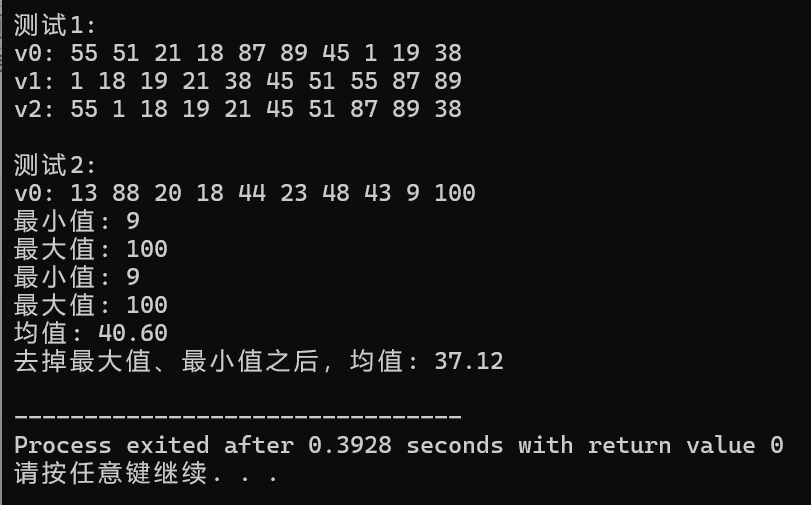
观察与思考:
问题一:generate 算法的作用是什么?
通过调用generate_random_number函数生成值,将生成的连续值依次赋值给
[first, last) 区间内的元素,实现批量生成数据。问题二:minmax_element 和分别调用 min_element 、 max_element 相比,有什么优势?
minmax_element 一次遍历即可同时获取最大和最小值,比分别调用 min_element 和 max_element效率更高。
问题三:把代码中函数 generate_random_number 的声明(line13)和定义(line35-37)注释起来,把两处调用改成如下写法,观察效果是否等同?查阅c++中lambda表达式用法。
效果相同,但是lambda 表达式是匿名函数,逻辑更简单、代码更清楚。
3、实验任务三
源代码

#include <iostream> #include <string> #include <algorithm> #include <cctype> unsigned char func(unsigned char c); void test1(); void test2(); int main() { std::cout << "测试1: 字符串大小写转换\n"; test1(); std::cout << "\n测试2: 字符变换\n"; test2(); } unsigned char func(unsigned char c) { if(c == 'z') return 'a'; if(c == 'Z') return 'A'; if(std::isalpha(c)) return static_cast<unsigned char>(c+1); return c; } void test1() { std::string s1{"Hello World 2049!"}; std::cout << "s1 = " << s1 << '\n'; std::string s2; for(auto c: s1) s2 += std::tolower(c); std::cout << "s2 = " << s2 << '\n'; std::string s3; for(auto c: s1) s3 += std::toupper(c); std::cout << "s3 = " << s3 << '\n'; } void test2() { std::string s1{"I love cosmos!"}; std::cout << "s1 = " << s1 << '\n'; std::string s2(s1.size(), ' '); std::transform(s1.begin(), s1.end(), s2.begin(), func); std::cout << "s2 = " << s2 << '\n'; }
运行结果图:
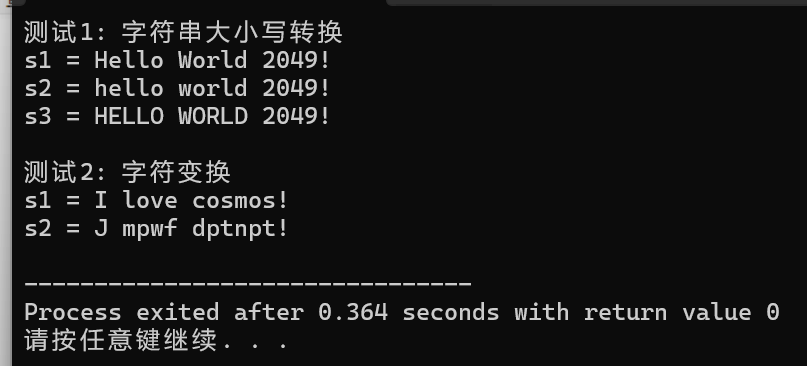
观察与思考:
问题一:自定义函数 func 功能是什么?
将字母字符转为下一个字母
问题二:tolower 和 toupper 功能分别是什么?
把字符串中的字母变成小写和把字符串中的字母变成大写字母。
问题三:transform 的4个参数意义分别是什么?如果把第3个参数 s2.begin() 改成 s1.begin() ,有何区别?
第一个参数是待处理数据的起始位置,第二个参数是待处理数据的结束位置,第三个参数是处理后的数据的存储起始位置,第四个参数是变换函数;如果修改第三个参数,则会在原本的字符串上直接修改。
4、实验任务四
源代码:

#include <iostream> #include <string> #include <algorithm> bool is_palindrome(const std::string &s); bool is_palindrome_ignore_case(const std::string &s); int main() { using namespace std; string s; // 多组输入,直到按下Ctrl+Z结束测试 while(cin >> s) { cout << boolalpha << "区分大小写: " << is_palindrome(s) << "\n" << "不区分大小写: " << is_palindrome_ignore_case(s) << "\n\n"; } } // 函数is_palindrome定义 // 待补足 bool is_palindrome(const std::string &s) { int left = 0; int right = s.size() - 1; while (left < right) { if (s[left] != s[right]) { return false; } left++; right--; } return true; } // 函数is_palindrome_ignore_case定义 // 待补足 bool is_palindrome_ignore_case(const std::string &s) { int left = 0; int right = s.size() - 1; while (left < right) { unsigned char left_char = static_cast<unsigned char>(s[left]); unsigned char right_char = static_cast<unsigned char>(s[right]); if (tolower(left_char) != tolower(right_char)) { return false; } left++; right--; } return true; }
测试结果图:
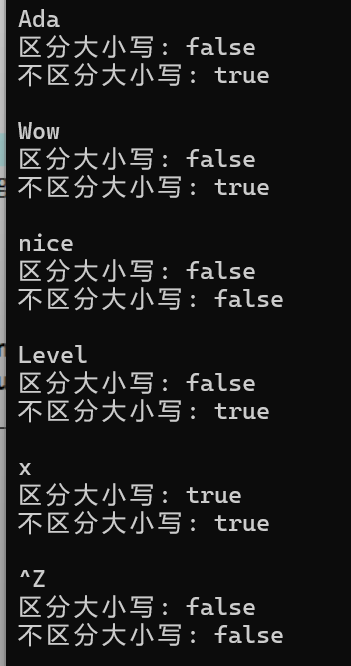
观察与思考:
问题一:使用 cin >> s 输入时,输入的字符串中不能包含空格。如果希望测试字符串包含空格(如 hello oop ),代码应如何调整?
使用std::getline函数即可。
5、实验任务五
源代码:

#include <iostream> #include <string> #include <algorithm> std::string dec2n(int x, int n = 2); int main() { int x; while(std::cin >> x) { std::cout << "十进制: " << x << '\n' << "二进制: " << dec2n(x) << '\n' << "八进制: " << dec2n(x, 8) << '\n' << "十二进制: " << dec2n(x, 12) << '\n' << "十六进制: " << dec2n(x, 16) << '\n' << "三十二进制: " << dec2n(x, 32) << "\n\n"; } } // 函数dec2n定义 // 待补足 std::string dec2n(int x, int n) { if (x == 0) { return "0"; } const std::string zidian = "0123456789ABCDEFGHIJKLMNOPQRSTUVWXYZ"; std::string result; while (x > 0) { int res = x % n; x = x / n; result += zidian[res]; } std::reverse(result.begin(), result.end()); return result; }
测试结果图:
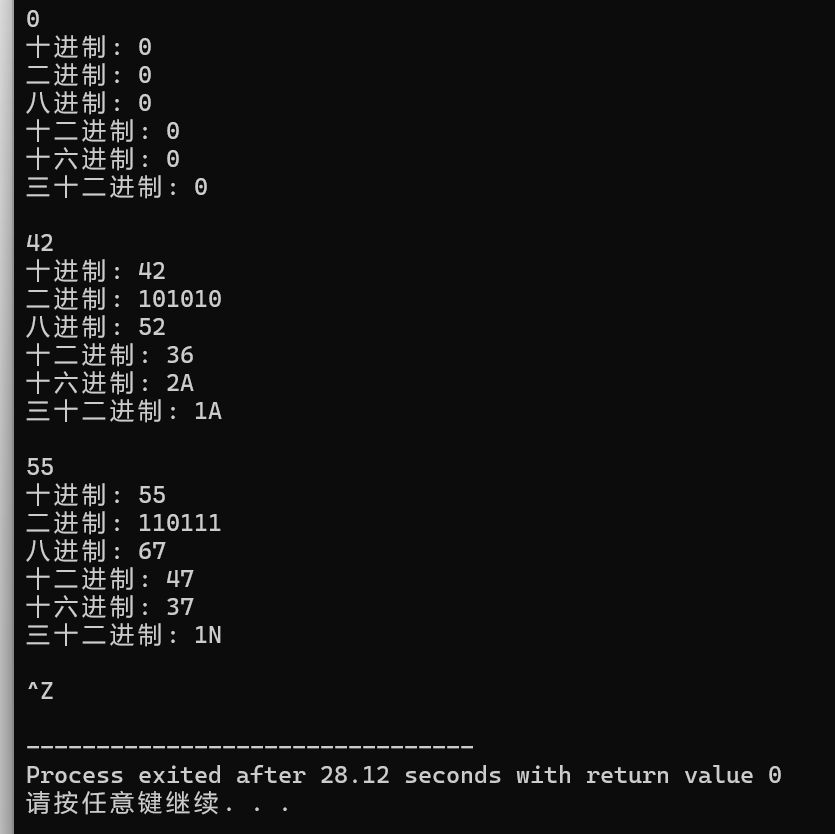
6、实验任务六
源代码:

#include <iostream> #include <string> #include <algorithm> #include <vector> using namespace std; int main() { vector<char> s0{'a','b','c','d','e','f','g','h','i','j','k','l','m','n','o','p','q','r','s','t','u','v','w','x','y','z'}; cout<<' '<<' '; for(auto ch : s0) { cout<<' '<<ch; } cout<<endl; int i=1; for(auto &c:s0) c=(char)toupper(c); while(i<=26) { if(i<=9) cout<<' '; cout<<i<<' '; rotate(s0.begin(),s0.begin()+1,s0.end()); for(auto ch : s0) { cout<<ch<<' '; } cout<<endl; i++; } return 0; }
测试结果图:
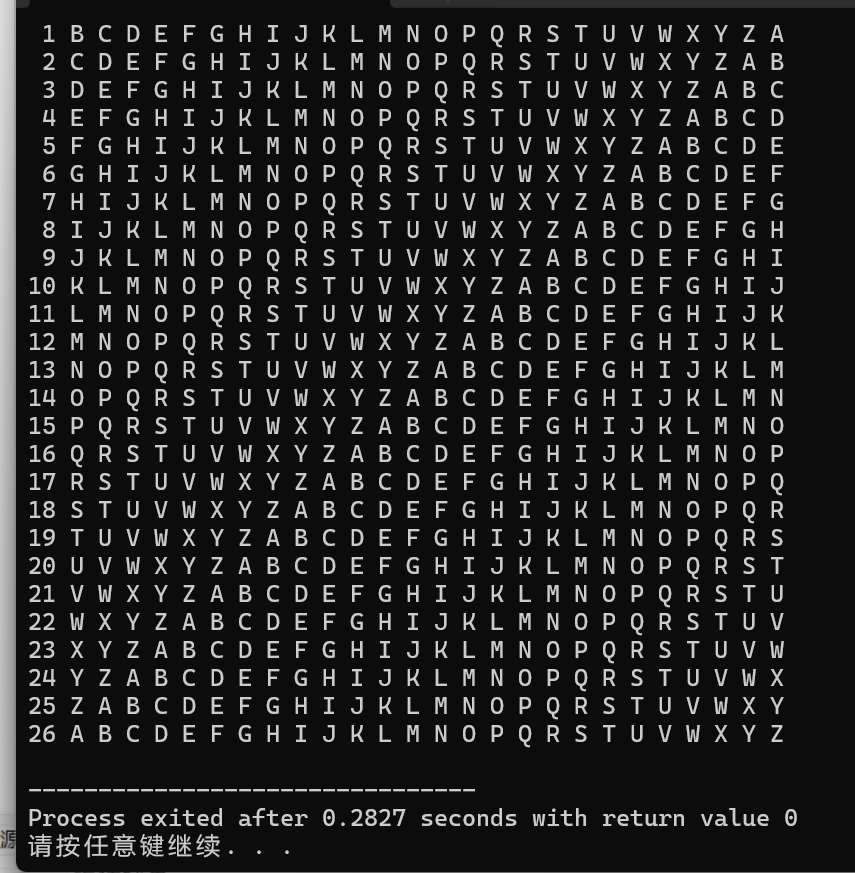
7、实验任务七
源代码:

#include <iostream> #include <cstdlib> #include <ctime> #include <iomanip> using namespace std; int main() { srand(time(0)); int correct = 0; const int total = 10; for (int i = 0; i < total; i++) { int a = rand() % 10 + 1; int b = rand() % 10 + 1; int op = rand() % 4; if (op == 1) { if (a < b) { swap(a, b); } } else if (op == 3) { if(a%b!=0){ int multiple = rand() % 10 + 1; a = b * multiple; if (a > 10) { a = b; } } } int answer; char op_char; switch (op) { case 0: answer = a + b; op_char = '+'; break; case 1: answer = a - b; op_char = '-'; break; case 2: answer = a * b; op_char = '*'; break; case 3: answer = a / b; op_char = '/'; break; } cout << a << " " << op_char << " " << b << " = "; int user_answer; cin >> user_answer; if (user_answer == answer) { correct++; } } double rate = (double)correct / total * 100; cout << "正确率: " << fixed << setprecision(2) << rate << "%" << endl; return 0; }
测试结果图:
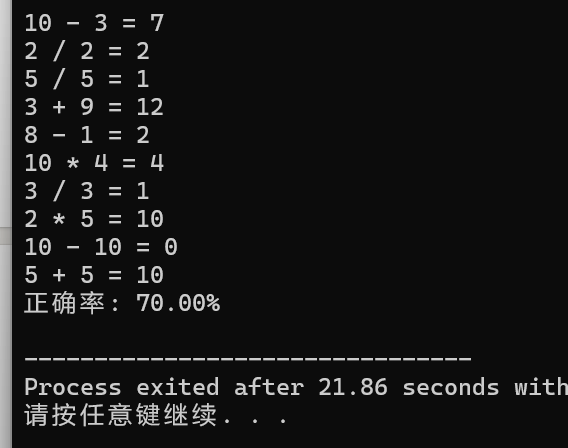
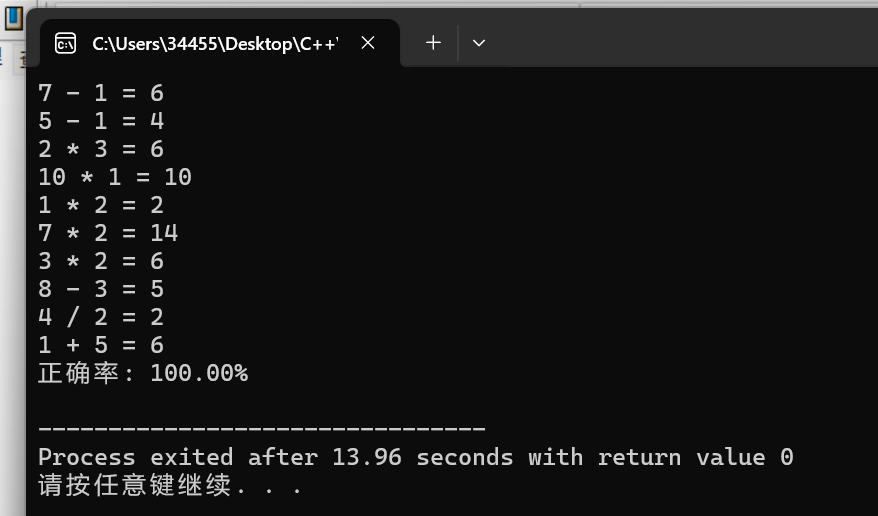 2
2




 浙公网安备 33010602011771号
浙公网安备 33010602011771号